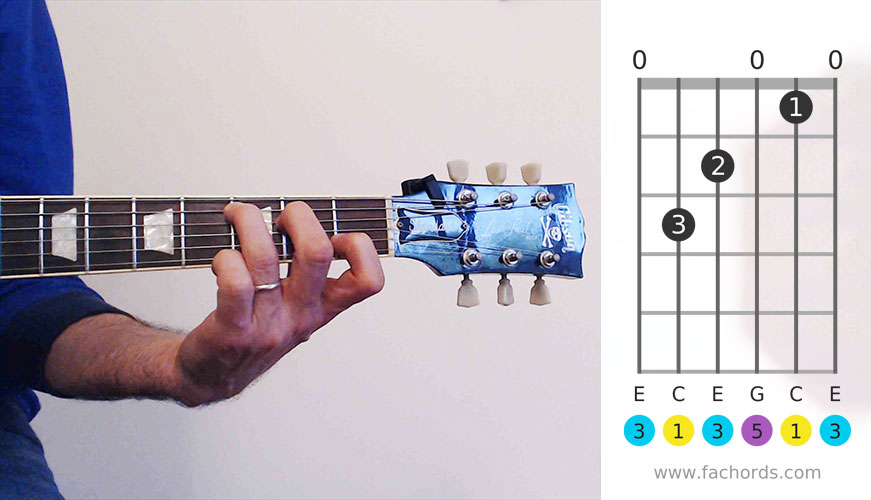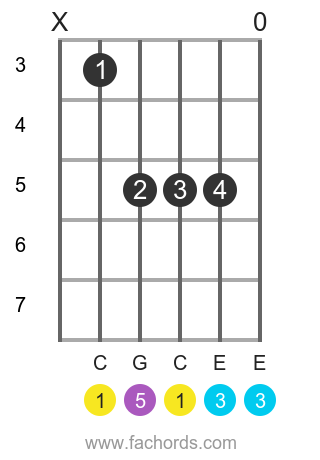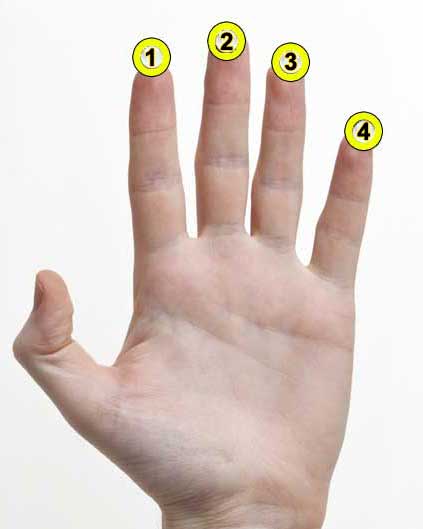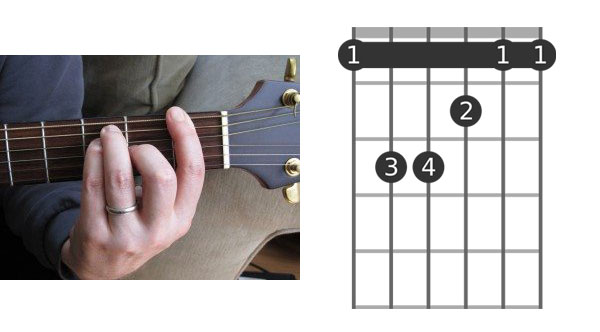How to Read Chords Diagrams

C Major Chord Diagram
This quick tutorial will teach you how to read diagrams for guitar chords , like the ones in our online guitar chords dictionary and in the brand new Chords Domination ebook. To learn more about written music for guitar, be sure to check out our how to read music for guitar .
Strings and Frets
In the diagrams, fretboard strings are shown vertically , with the thickest string (6th E low string) on the left. So you have, from left to right:
- (6th) E low string
- (5th) A string
- (4th) D strings
- (3rd) G string
- (2nd) B string
- (1st) E high string
Frets are from fret 0 (open string, at the top of the diagram) to fret 5. For fingerings that are placed in a higher fretboard area, you'll find the corresponding fret numbers on the left of the diagram, listed vertically.
0 or X above the strings
C Major Chord

- At the top of the diagrams, above each string, you can find a X , which means that you don't have play the string
- If you see a 0 , which means that you play the string open , without pressing any frets (fret 0)
- If there are no X or 0, you have to play the fret shown on the diagram
Fingers Notation
 The frets you must play are denoted with a black circle on the proper string. The numbers 1,2,3
and 4 tells which finger you have to use to press the fret:
The frets you must play are denoted with a black circle on the proper string. The numbers 1,2,3
and 4 tells which finger you have to use to press the fret:
- 1: index
- 2 middle
- 3 ring
- 4 pinky
Note Names and Intervals
At the bottom of the diagram, you find the name of the note on the fret of the related string. The diagrams also show which interval of the chord a note is.
An interval has a specific name depending on its size.
Also, intervals are color-coded to help you internalize the concepts. Have a look at the table below:
| Interval | Distance (Semitones) | Symbol |
|---|---|---|
| Root | 0 | |
| Minor Second | 1 | |
| Major Second | 2 | |
| Minor Third | 3 | |
| Major Third | 4 | |
| Perfect Fourth | 5 | |
| Diminished Fifth (Augmented Fourth) | 6 | , |
| Perfect Fifth | 7 | |
| Minor Sixth | 8 | |
| Major Sixth, Diminished Seventh | 9 | , |
| Minor Seventh | 10 | |
| Major Seventh | 11 | |
| Octave | 12 |
To learn more about intervals and chord construction, check our full tutorial on chords building , and our fretboard intervals complete map.
Bar chords
F Major Chord

If a position requires you to play a bar chord , this will be denoted in the diagrams with a thick black line , instead of a single circle.
Chord Tags
To help you quickly identify the fingerings you need, the diagrams are tagged in the following way:
The fingering uses open strings, it's likely easier than the other.
The shape is movable, which means that you can shift the pattern up and down the fretboard without changing finger configuration, to play chords of the same type (maj, min, 7, etc) but with another root (C, C#, D, D#, and so forth). You can find more info about how the fretboard works here
This chord shape requires you to make a barre with one or more fingers; it could be a little difficult for a beginner. Learn more about bar chords here .
Example: how to play a C major chord
Let's see how to read a
C major chord
:

- You don't have to play the E low string (because there is an X at the top of the leftest string)
- You have to press the 3rd fret with the ring finger (because of the circled 3 placed on the 3rd fret)
- You have to press the 2nd fret with the middle finger (because of the circled 2 placed on the 2nd fret)
- You have to press the 1st fret with the index finder (because of the circled 1 placed on the 1st fret)
- Finally you have to play the E high string open , without pressing any fret (because of the 0 above the string)
The diagrams also tell us that this chord is composed of the notes: C, E, G, C, and E, which corresponds to the 1 (root), 3 (major third), 5 (perfect fifth), 1 and 3 degrees (tones) of the related C major scale.
That's all, now it's time to learn some guitar chords!